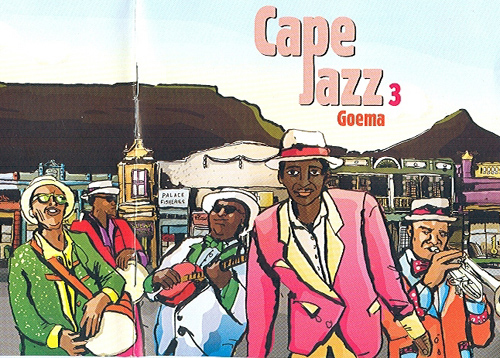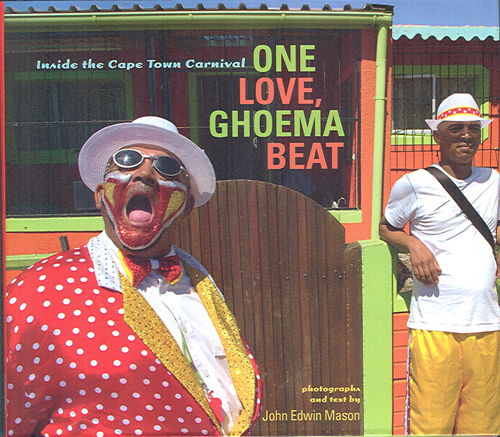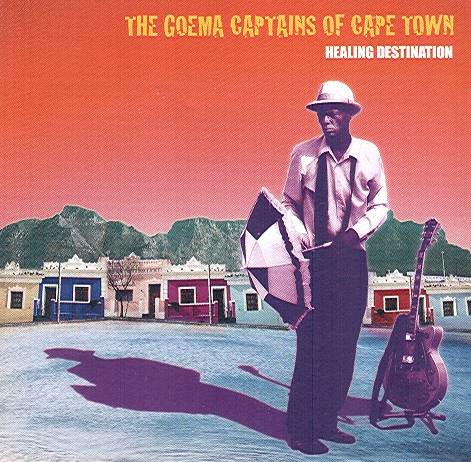GOEMA MUSIC OF SOUTH AFRICA

by Richard Haslop
(August 2012)
"Late night someone takes a drum and we go goema, goema, goema / You make a right decision in the right direction."
This is the entire lyrical content of a song by 1980's Cape Town band the Genuines, though probably not, in the context of '80's South Africa, its entire meaning. The song, on the band's 1986 debut album for South African independent label, Shifty Records, is called Goema (pronounced goo-muh, but with the first syllable shorter than the Sonic Youth album title with which it shares its spelling). So is the album. It's either named after the musical form, alternatively spelt ghoema, that can be considered traditional among the Coloured people of Cape Town, or the carnival drum after which the music itself is named.
Although the style was certainly hugely influential on the Genuines, political rockers with jazz chops and punk sensibilities, the song itself is not obviously goema at all, but high energy hard rock. However, arguably the album's definitive song, "Struggle," a protest against the then government's military presence in the townships, sung, despite its title, in dialect Afrikaans – in South Africa, the word ‘struggle' denotes the fight against apartheid, no matter which of the country's eleven official languages you speak – is pure electrified goema, its irrepressible, completely irresistible beat a stark contrast to the emotions expressed by lyrics that translate as "because the tyres burn, rocks in our hand, and the heart so sore."
Despite being considered controversial, the term "Coloured" is still in official use in South Africa to describe predominantly people of mixed race, but also the descendants of slaves brought to the Cape centuries ago from parts of what is now Indonesia. The Western Cape province is still home to by far the country's largest grouping of Coloured people, and goema has not only developed from within that culture, but is still overwhelmingly, if not exclusively, a so-called Cape Coloured style. It is most clearly heard in the music of the uniformed Christmas bands that go from door to door playing carols in return for offerings of food and drink, the nagkore (Malay choirs) who sing in the New Year and, most visibly, the carnival bands that parade through Cape Town every year on the 2nd of January, Tweede Nuwe Jaar ("second New Year"), which was once a public holiday in the Western Cape.
The origins of the 2nd of January carnival parade are uncertain. Some say that this was the day on which the slave owners would annually allow their slaves a day off and that they gathered to celebrate their holiday; others suggest that it started in commemoration of the abolition of slavery in the Cape and the emancipation of the slaves in 1838, although there were reports of slaves marching with musical instruments more than a decade earlier than that. Whatever the case, it has become a Cape Town institution, where the Kaapse Klopse (Cape carnival troupes) dress up in "teams", paint their faces and parade through town to the sound of marching bands in festivities suggesting a combination of minstrelsy and Mardi Gras.
At least one of the troupes, the Atja Indians, dresses in stylized Native American garb, hinting at a possible affinity with the Mardi Gras Indians of New Orleans. The element of minstrelsy has been reflected in the fact that, even well into the post-apartheid era, the celebration was known as the Coon Carnival. Some of the participants, no doubt appreciating the self-deprecatory irony involved, still call it that, although the more acceptable name is now the Cape Minstrel Carnival, as if minstrelsy was somehow a more racially-neutral institution. Although some see it as a relic of the past, and an unwelcome manifestation of Cape Coloured stereotyping for the sake of promoting local color for the edification of Cape Town's mainly Eurocentric tourist trade, the carnival has significant political resonance beyond both its origins in slavery and its continued espousal by the Coloured working class. During the apartheid years, it was seen as both community building and a kind of cultural resistance, especially important in the light of the forced removals of Coloured people that took place from the District Six area of Cape Town, where the carnival tradition had been particularly strong.
A recent book of photographs by John Edwin Mason of the University of Virginia, entitled One Love, Ghoema Beat, brings you as close to the atmosphere and excitement of Cape Town's Carnival as is possible without actually being there, but it obviously works a whole lot better with musical accompaniment.

Musically, goema, a stylistic hybrid containing elements from a variety of cultures that have coalesced into a distinct form, with a strong resemblance to Afrikaner folk-dance, is characterized by folk and hymn-like tunes played by bands featuring furiously strummed banjo and horns whose stridency and loose harmonic relationships reflect the South African township style. The hiccup in the distinctively syncopated rhythm serves both to break up the beat and to give it a sense of lurching, jerking but unstoppable propulsion. Improbably, it has found its way onto the Carolina Chocolate Drops' current album, Leaving Eden, where "Mahalla" approximates goema, or at least one of its tributaries, with a degree of success. The tune was written by Hannes Coetzee, a Coloured South African who has recorded it playing slide guitar with a teaspoon held in his mouth while he strums the chords conventionally on his guitar.
After the success of "Goema," the Genuines teamed up with veteran banjo player and carnival troupe leader Samuel McKenzie, the father of the group's bass player, Gerald "Mac" McKenzie, for a second album on the Shifty label. Mr Mac And The Genuines focused, without completely abandoning rock, on goema itself, revisiting the old songs and writing several new ones. Besides Mac, the Genuines also featured another member of a famous Cape Town musical family. Keyboardist and singer Hilton Schilder's father, pianist Tony, was a pillar of the idiosyncratic Cape jazz style for years, while the '60's quintet led by his uncle Chris, now called Ebrahim Khalil Shihab, featured the great tenor saxophonist Winston Mankunku Ngozi, widely considered to be South Africa's John Coltrane.
Needless to say, Cape jazz borrows liberally and lovingly from goema. Its best known exponent internationally is certainly pianist Abdullah Ibrahim whose compositions frequently refer to the rhythms and melodies of his Cape Town upbringing when he was still known as Dollar Brand. Both the title and the feel of probably his best loved piece locally, "Mannenberg", sometimes called South Africa's alternative national anthem, evoke the township of that name (actually ‘Manenberg') to which Coloured people from District Six were removed. The two saxophonists on the original early '70s recording, tenorist Basil Coetzee and altoist Robbie Jansen, became leading Cape jazz practitioners in their own right, with Jansen in particular embracing goema in his own recordings.
The goema recorded catalogue is not exactly teeming with commercially accessible releases but, among the projects in which Mac McKenzie and Hilton Schilder have been involved together, some years after the split of the Genuines, is the Goema Captains Of Cape Town, whose mix of gutbucket goema and smooth jazz sophistication have helped make the raw form palatable to an entirely new audience, while McKenzie more recently formed the Cape Town Goema Orchestra – local goema and Cape jazz musicians with members of a classical orchestra – to perform his "Goema Symphony No. 1." Perhaps the best all in one place representation of the goema influence on local jazz is to be found on Cape Jazz 3, the third volume of a series released on the Mountain Records label, while the two Genuines albums mentioned will allow rock fans to make the transition an effortless one.
Genuines drummer, Ian Herman, helped form South African world music favourites Tananas, which featured strong elements of goema in their mix of influences, before he emigrated to the USA, while long serving Johnny Clegg drummer Barry van Zyl has recently released an album of goema music with the Bo Kaap Collective. Bo Kaap is the Cape Town area where the Cape Malays, descendants of those Indonesian slaves of long ago, made their home.
Former Tananas guitarist Steve Newman is a genuine South African acoustic guitar hero and goema is seldom far from his musical thoughts, while the man many regard as his natural nylon-string successor, Derek Gripper, whose own record label is called New Cape Records, is obviously, if a little more impressionistically, influenced by the form. Of particular note is the gorgeous work he did as Sagtevlei with one of the Goema Captains, Alex van Heerden.
Van Heerden died about three years ago, at the age of only 34. His musical mentor Robbie Jansen outlived him by just over a year, and Tony Schilder died shortly after that. Mankunku, a Cape jazzman if not a goema musician, went between van Heerden and Jansen. These were severe blows, but others will replace them. They always do. That's the point of a tradition, isn't it?
